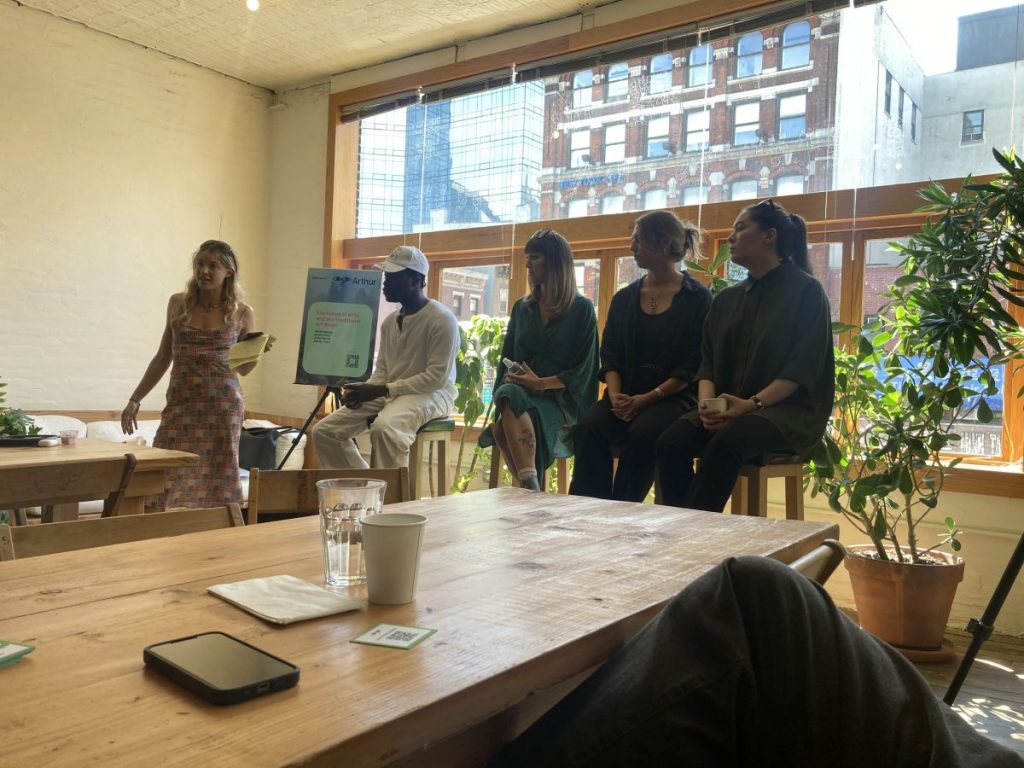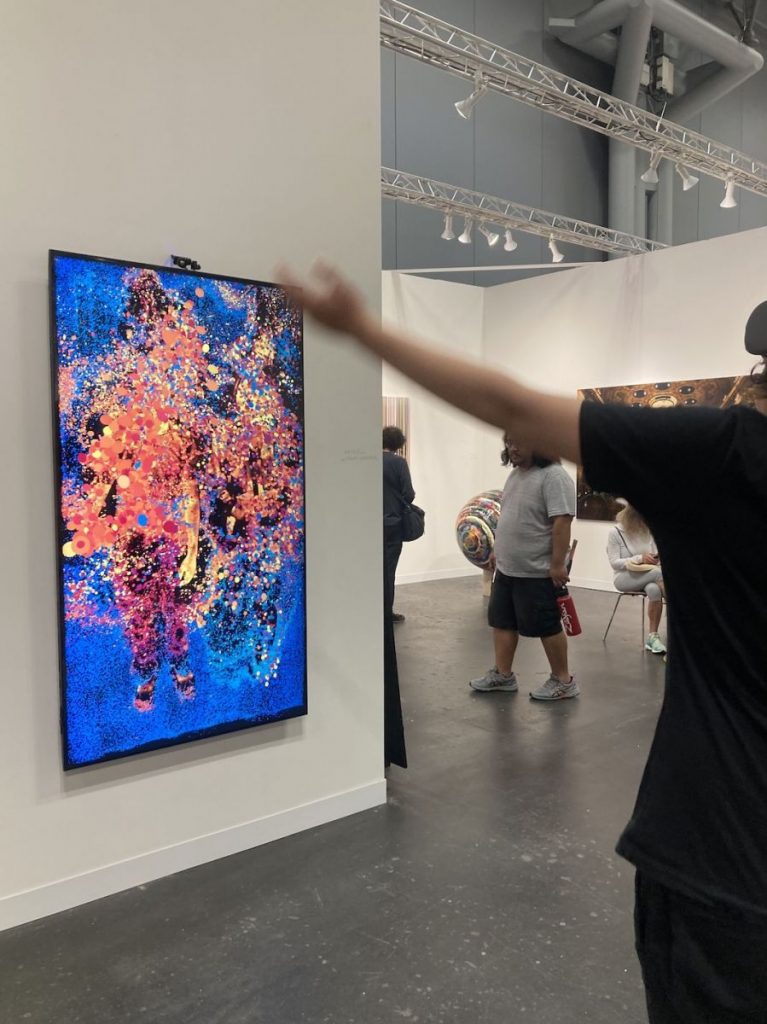During NYC’s Armory Week, Arthur AI asked how NFTs fit into trad art’s future


The Armory Show staged its 28th edition last weekend–its second appearance at the Javits Center, but first post-pandemic debut, this time with 100 more galleries. Through bear and bull markets, the art world treads a steady course making space for NFTs at art fairs—including New York’s own.
Here in late 2022, we can start seeing some patterns.
Art professionals have blockchain on the brain. NFT and metaverse conversations dominate panel discussion playlists, and sponsored installations glow with screens. But when it comes down to brass tacks, very few galleries at the center of these fairs actually show NFTs in their booths.
Especially given the current state of affairs, how will blockchain art (whatever that means to you) fare in the future of the IRL art world?
Artificial intelligence art tool Arthur convened a panel of five distinct speakers on September 10 to discuss just that–former art dealer and artist Mieke Marple, theVERSEverse founder Sasha Stiles, curator Sofia Garcia, and web3 marketing maven Maritza Yoes, with a surprise guest appearance from stone sculptor and simultaneous blockchain artist Hamzat Raheem.
Yoes opened by citing Urs Fischer’s latest digital art show with Gagosian. The mega gallery originally declined to work with Fischer’s own NFTs, but when they saw the potential, they seemed to have gotten on board. Still, Yoes noted, the press release doesn’t mention NFTs even once.
Then, she asked each of the panelists how they got into the space. Stiles started, delivering a similar exposition to the one from her SuperRare panel appearance last month.
Like many professionals pioneering the nexus of fine art and web3, Garcia hails from a traditional art background. She left her job at a gallery to study computer science and become an engineer at JP Morgan. Still hankering for a creative way of life, she discovered two artists who used code itself as a medium and displayed physical copies of their works at a very small art fair, where she purchased a booth for just $75.
Marple started off in regular fine art, too–serving five years as an early partner at meteoric west coast art institution Night Gallery while maintaining her own painting practice. In February 2021, an artist she knew simply minted–and sold–an NFT of an existing painting they’d already created. Intrigued by the possibility of making double the money without extra effort, Marple tried it herself in March 2021.
She sold the work for an equivalent of $25,500–well above her regular paintings’ price points. Marple has since moved into more sophisticated generative art projects like her Medusa drop, which reimagines the legendary monster as a survivor of violence—per the myth itself.
Raheem told the crowd he knew he’d be a stone sculptor since grade school when his playground trick was to find a very smooth pebble and swallow it whole. The Massachusetts-based artist grew up in Nigeria, where frequent blackouts taught him about electricity’s ephemerality.
That impression still translates to his relationship with technology–even though he’s come to blend blockchain tech with thoroughly sturdy, earthen materials like stone.
Raheem accepted the payment for his first sculpture sold in ETH–building on a fascination with alternative currencies.”The intersection between art and technology is finance,” Raheem said later in the panel. Gatekeeping proves a close second, even despite the space’s belief in decentralization.

While studying in Japan, he started 3D scanning his sculptures, then destroying the original copies and selling only those records. He’s also experimented with “creative archaeology,” burying these stones in the soil at a metaverse festival for attendees to discover. His findings included a need to get better at hiding relics—most were found very quickly.
At the SuperRare panel in August, Stiles explained how she convinces writers to get involved with Web3. For this discussion, though, Yoes asked how panelists onboard collectors to buy NFTs. The notion of phygital activities that blend Web3 with the real world–referred to throughout this discussion as URL to IRL to URL–dominated the conversation. Stiles pointed out that having her poetry NFTs on physical display at SuperRare’s SoHo space attracts otherwise latent interest.
Marple added that constant hacks and the crypto’s market volatility have been major barriers to widespread adoption so far, even though “that is very attractive to a certain type of person.”
Garcia also pointed out that the notion of a collector itself is changing as DAOs add crypto art assets to their treasuries. However, in this instance, phygital components are actually deterrents that can cause problems. How would a DAO divide an IRL canvas that comes with an NFT? Art handling is expensive, too–where would they store it?
But each panelist, of course, sees endless inspiration–and potential–for Web3’s role in fine art. Marple cited theVERSEverse in particular. If we can find a way to pay poets properly, she half-joked, it would solve one of humanity’s longest-standing conundrums. Stiles, on the other hand, believes her poetry NFTs could become a “metaversal literature,” a continuation of society’s storytelling legacy that started with the oral tradition and now lives in the written word.
Garcia’s most inspired by the rise of specialized NFT platforms that are onboarding art galleries into the space. Raheem mused that tokens for individuals could offer a natural progression from Patreon and GoFundMe, where supporters can directly invest in an inspiring person. He wants to buy Sasha token.
Finally, the conversation opened for audience Q&A–an interesting segment in its own right since it shows what attendees are most curious about. One person asked how generative art tools like DALL-E fits into the equation and whether prompts themselves could be traded as NFTs. Perhaps it’s too early to say, though many have decried blockchain tech merely as a way to make money off digital resources that, in this case, could be open source.
An art writer myself, I wondered what this group would say about blockchain as a medium in its own right. Marple offered a stunning response–this is what being a contemporary artist is all about. “You’re dealing with the world as it is and reflecting it back with your own glitch inserted.” Blockchain is innately part of the world we’re all living in.
This year, the Armory Show also overlapped with New York Fashion Week–a full-on return for the city’s creative industries after a summer spent jet setting and/or in the Hamptons. Some of us were lucky enough to do both.
An audience member in town from Los Angeles for the festivities wondered how NFTs overlap with couture, raising the age-old question about what an NFT really is. Other audience members, present company included, piped up to offer use cases already in play, projects by sLabs and Americana that use chips to record physical assets on blockchain ledgers.
The panel discussion had then opened up into a full-room conversation–perhaps the greatest possible conclusion for this type of event. Conspicuously absent, however, was the fact that Arthur AI themselves also offers this technology in their own NFO chip, which “cryptographically links physical objects to tokens on the blockchain” to “track provenance, verify authenticity, and transact simply by scanning the embedded chip with your phone,” a pinned Tweet reads.
The company, branded as “Your AI Art Advisor,” gives major Web3 vibes—but it’s not one of those specialized NFT platforms Garcia mentioned. It’s actually an AI tool that analyzes collectors’ tastes and curates tailored ‘crates’, pointing them to natural new acquisitions. Some of those are NFTs, but many are canvases–a fitting ode to the liminal space the fine art world finds itself in at this moment, learning how to go URL to IRL to URL everywhere, from galleries to art fairs.
Read related posts:
Disclaimer
In line with the Trust Project guidelines, please note that the information provided on this page is not intended to be and should not be interpreted as legal, tax, investment, financial, or any other form of advice. It is important to only invest what you can afford to lose and to seek independent financial advice if you have any doubts. For further information, we suggest referring to the terms and conditions as well as the help and support pages provided by the issuer or advertiser. MetaversePost is committed to accurate, unbiased reporting, but market conditions are subject to change without notice.
About The Author
Vittoria Benzine is a Brooklyn-based art writer and personal essayist covering contemporary art with a focus on human contexts, counterculture, and chaos magic. She contributes to Maxim, Hyperallergic, Brooklyn Magazine, and more.
More articles

Vittoria Benzine is a Brooklyn-based art writer and personal essayist covering contemporary art with a focus on human contexts, counterculture, and chaos magic. She contributes to Maxim, Hyperallergic, Brooklyn Magazine, and more.

















































